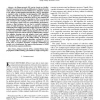248 search results - page 41 / 50 » Adapting RBF Neural Networks to Multi-Instance Learning |
GECCO
2009
Springer
14 years 7 days ago
2009
Springer
We apply CMA-ES, an evolution strategy with covariance matrix adaptation, and TDL (Temporal Difference Learning) to reinforcement learning tasks. In both cases these algorithms se...
AR
2008
13 years 7 months ago
2008
Intentional behavior is a basic property of intelligence and it incorporates the cyclic operation of prediction, testing by action, sensing, perceiving, and assimilating the exper...
AROBOTS
1999
13 years 7 months ago
1999
We present a framework for constructing representations of space in an autonomous agent which does not obtain any direct information about its location. Instead the algorithm relie...
TNN
2010
13 years 2 months ago
2010
Abstract--An Elman network (EN) can be viewed as a feedforward (FF) neural network with an additional set of inputs from the context layer (feedback from the hidden layer). Therefo...
GECCO
2007
Springer
14 years 1 months ago
2007
Springer
Adaptive representations allow evolution to explore the space of phenotypes by choosing the most suitable set of genotypic parameters. Although such an approach is believed to be ...

